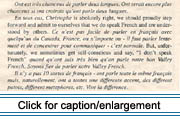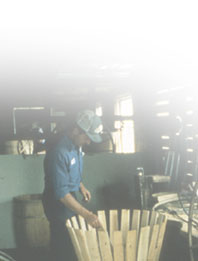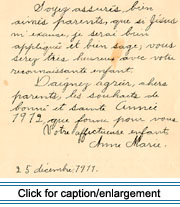|
 Maine
is one of the few states where people reported in the 1990 U.S. census
that they spoke French at home (U.S. Census 1991b). Available information
shows that the proportion of the population who speak French in the Valley
is much higher than in the rest of Maine. The French language is in everyday
use from Fort Kent to Van Buren, Maine, and in the back settlements of
the Valley. It is heard on the street, in restaurants and stores, at public
meetings, at work places, and in homes. Catholic masses are regularly
delivered in French in many of the parishes like St. Agatha, St. Luce
(Frenchville), and St. David (Madawaska). Maine
is one of the few states where people reported in the 1990 U.S. census
that they spoke French at home (U.S. Census 1991b). Available information
shows that the proportion of the population who speak French in the Valley
is much higher than in the rest of Maine. The French language is in everyday
use from Fort Kent to Van Buren, Maine, and in the back settlements of
the Valley. It is heard on the street, in restaurants and stores, at public
meetings, at work places, and in homes. Catholic masses are regularly
delivered in French in many of the parishes like St. Agatha, St. Luce
(Frenchville), and St. David (Madawaska).
The proportion of the Valley population that uses French declines when
moving west from Fort Kent, up the St. John River (Rooney et al. 1982:
163). The western boundary of the Maine Acadian French speech community
is near the eastern border of Allagash Plantation, Maine. As one travels
east from Van Buren along the St. John River and then south along the
New Brunswick border, the percentage of the population with a background
in French diminishes. The change from French to English is gradual. There
is, however, an abrupt decline in the use of French south from Van Buren
along U.S. Route 1.
 French
and English typically flow together during conversations, often in the
same sentence. Dubay (1978) notes that Valley English is influenced by
native French lexical and syntactic features. French speakers, as a matter
of courtesy, will shift into English when a monolingual English speaker
joins an exchange. Parents will occasionally shift into French when discussing
matters they don't want their children to know. French
and English typically flow together during conversations, often in the
same sentence. Dubay (1978) notes that Valley English is influenced by
native French lexical and syntactic features. French speakers, as a matter
of courtesy, will shift into English when a monolingual English speaker
joins an exchange. Parents will occasionally shift into French when discussing
matters they don't want their children to know.
Being able to communicate effectively in both French and English is becoming
highly valued in the Valley. Unilingual English speakers are clearly at
a disadvantage in some types of daily speech events. For example, French
speakers from New Brunswick and Québec cross over the international border
into Maine in large numbers when the cost of goods is more favorable in
the U.S. than in Canada. Maine citizens working in retail establishments
are at an advantage if they are able to transact business in French. Ross
Paradis, a resident of the Valley speaking before the Maine Acadian Culture
Preservation Commission (Sept. 1993), supports efforts to revitalize French
that are tied to the economic prospects of young Maine Acadians.
|
 |
 |
The younger people do not know the hurt and the pain that went into
being bilingual, they don't, and I maintain that language not be sold
on the past. . . . There are jobs that require you [to] be bilingual.
Driving down in the car, "Channel X" was advertising for a position
in sales . . . The number one requirement was, "fluently bilingual."
French usage is declining among the population under 30 years of age.
French as a mother tongue has dropped among schoolchildren in the Valley
by 18% during the five-year period from 1987 to 1991 (Bérubé, 1991a).
Still, a large number of young people in the Valley are receptive bilinguals;
they understand the language, but some cannot speak it while others feel
self-conscious about using it.
 Bilingual
programming was begun in Maine in 1970 and is still going on in the Valley.
The Frenchville St. Agatha area school district's bilingual education
program is designed to help students in both French and English. This
program has made significant progress in introducing materials pertinent
to the heritage and culture of the students. Fifty-five percent of the
school children in the Frenchville St. Agatha area school district communicate
in both French and English. Other communities reported less bilingualism,
but Bérubé reports that more than half the students in Van Buren (54%)
and Madawaska (52%) are able to use both languages; in all, 40% of the
schoolchildren in the Upper St. John Valley speak both French and English
(1991a). Bilingual
programming was begun in Maine in 1970 and is still going on in the Valley.
The Frenchville St. Agatha area school district's bilingual education
program is designed to help students in both French and English. This
program has made significant progress in introducing materials pertinent
to the heritage and culture of the students. Fifty-five percent of the
school children in the Frenchville St. Agatha area school district communicate
in both French and English. Other communities reported less bilingualism,
but Bérubé reports that more than half the students in Van Buren (54%)
and Madawaska (52%) are able to use both languages; in all, 40% of the
schoolchildren in the Upper St. John Valley speak both French and English
(1991a).
Residents have seen a decline in the overall use of French in the Valley
and perceive a rapid decline in recent years. Results from recent studies
are inconclusive. In 1970, Frenchville's population of French speakers
was reported at 85.9% and that of St. Agatha was 96.5% (GiguÉre, 1979:
156). The number of French speakers remained high in the 1990 census (in
spite of the fact that mother-tongue French speakers were counted in 1970,
while in 1990 people who used French at home were counted). The average
percentage of French speakers in Fort Kent, Madawaska, and Van Buren was
88% (M. GiguÉre, pers. comm. 1993). A 1991 survey in the school district
that serves the Frenchville St. Agatha region found that French was used
at home by 69% of the school-age children (Bérubé, 1991).
Language stigma and a desire by some to speak English are frequently
cited reasons for the decline in the use of French. One Fort Kent woman
in her early 30s echoes the sentiment of Valley residents who frequently
report negative experiences associated with the prohibition on French
in public schools. She refuses to teach her children her own native language
because she was embarrassed about her speech in school; she wants to make
certain her children do not develop a French accent.
 French
education, once provided by one or another of the Catholic religious orders,
dissolved with the institution of mandatory public education. French was
forbidden in the classrooms of Maine by the time of World War I, except
as a "foreign" language. Teachers, often themselves native French speakers,
were required to punish children who spoke French at school. Guy Dubay
(1978: 13) reports that he was made to stay after school and write hundreds
of lines of "I will not speak French at school." In high school, students
who spoke the Valley variety of French were ridiculed by teachers of "standard"
French because of their accents, choice of words, or syntax. Until 1960,
state law required that English be the only language used for teaching
school subjects in the public schools of Maine (Bélanger-Violette, 1973:
131). A number of residents claim that speaking French is still forbidden,
or at least strongly discouraged in some Valley schools. French
education, once provided by one or another of the Catholic religious orders,
dissolved with the institution of mandatory public education. French was
forbidden in the classrooms of Maine by the time of World War I, except
as a "foreign" language. Teachers, often themselves native French speakers,
were required to punish children who spoke French at school. Guy Dubay
(1978: 13) reports that he was made to stay after school and write hundreds
of lines of "I will not speak French at school." In high school, students
who spoke the Valley variety of French were ridiculed by teachers of "standard"
French because of their accents, choice of words, or syntax. Until 1960,
state law required that English be the only language used for teaching
school subjects in the public schools of Maine (Bélanger-Violette, 1973:
131). A number of residents claim that speaking French is still forbidden,
or at least strongly discouraged in some Valley schools.
The only in-depth study of French language in the Upper St. John Valley
was conducted by Geneviéve Massignon, a respected professional linguist.
In 1946 she initiated an extensive study of Acadian French, beginning
with fieldwork in Madawaska, Maine, and Sainte-Anne-de-Madawaska, New
Brunswick. Over the next year she systematically collected and compared
French speech from Acadian communities in the Canadian Maritimes and Québec.
In 1962, her research on Acadian speech was published in a two-volume
work entitled Les parlers français d’Acadie—Enquête linguistique.
 Massignon
concluded that the French of the Upper St. John Valley (Maine and New
Brunswick) was a mixed, relatively Canadianized speech in comparison to
that of surrounding Acadian settlement areas. Massignon found most Maritimes
Acadian communities to be "purely Acadian" in their origins and their
present-day speechways. The St. John Valley, by contrast, she found to
be a mixed zone (half Acadian, half French-Canadian), where speechways
reflected a blend of Acadian and French-Canadian vocabulary and phonetics,
and a predominantly French-Canadian morphology (Massignon 1962). Massignon
concluded that the French of the Upper St. John Valley (Maine and New
Brunswick) was a mixed, relatively Canadianized speech in comparison to
that of surrounding Acadian settlement areas. Massignon found most Maritimes
Acadian communities to be "purely Acadian" in their origins and their
present-day speechways. The St. John Valley, by contrast, she found to
be a mixed zone (half Acadian, half French-Canadian), where speechways
reflected a blend of Acadian and French-Canadian vocabulary and phonetics,
and a predominantly French-Canadian morphology (Massignon 1962).
Opinions vary about the uniqueness of the variety of French spoken in
the Valley. French teacher Marie Anne Gauvin (1969) argues that "Valley
French" is unique. She and local resident Julie Albert (1969) noted many
instances of maritime and nautical terms, many of which are shared throughout
French Canada. There are also suggestions that because of the importance
of potato farming in the region, many terms currently being used for potatoes
and related activities are unique to the Valley—see "Patates à
Barnard" (NADCBE 1979). Yves Cormier of Centre de littérature, Université
Sainte-Anne (Nova Scotia) suggests that "Valley French" preserves some
elements of an older form of French no longer spoken elsewhere (pers.
comm. 1993). Ronald Labelle of Centre d’études acadiennes, Université
de Moncton (New Brunswick) however, disagrees. He writes: "The French
spoken on both sides of the St. John Valley is characteristic of that
spoken in rural areas of eastern Québec. Some expressions typical of the
Acadian districts of New Brunswick (the eastern half of the province)
are found there, but general proximity to Québec and the influx of settlers
from Lower Canada in the later 18th and early 19th centuries has resulted
in a spoken language which has no significant differences to that of the
St. Lawrence region of the province. . . . The only identifying aspect
of the French spoken in the St. John Valley is the accent" (pers. comm.
1993).

|
|

